To clean a mattress, start by stripping off all bedding and vacuuming the surface to remove dust and debris. Spot clean stains with a mild detergent solution and blot them dry, or use a baking soda-hydrogen peroxide mix for tougher stains. Deodorize the entire mattress by sprinkling baking soda generously over it, letting it sit for at least 15 minutes, then vacuuming it up. Air the mattress out near an open window or in a well-ventilated room, and if possible, flip and rotate it to even out wear. Finish by covering the mattress with a washable protector to prevent future stains and allergens.
Maintaining a clean mattress is essential for both hygiene and health. Over time, mattresses can accumulate dust, allergens, stains, and odours, impacting the overall sleep environment as well as your well-being. Not only is it hygienic, but our orthopaedic expert, Bethany Lawrence confirms it can improve the support you receive when sleeping, 'Keeping your mattress and sleep environment clean can significantly impact comfort.' In this comprehensive guide, we will provide you with a step-by-step process for effectively cleaning your mattress. From preparation and basic cleaning steps to deep cleaning techniques and addressing specific concerns, this guide will ensure that you can enjoy a clean and fresh mattress for a better night’s sleep for years to come.

| If you're considering an upgrade, our Mattress Buying Guide offers valuable insights to help you select the perfect mattress for optimal comfort and support. |
How to prepare your mattress for cleaning
Your mattress is an investment into better sleep and healthier life, so it’s vitally important you do everything right when it comes to keeping it spick and span. Before diving into mattress cleaning, it is necessary to prepare yourself properly. A clean mattress makes for better sleep, but with mattresses being the size that they are, it can seem like a daunting task! Don’t worry – if you get things ready beforehand, it will seem so much easier. Let’s split that into two steps…
Remove bedding and create a well-ventilated cleaning area
The first step needs to be removing your bedding – take the duvet, pillows and bottom sheet off the bed, and throw the covers into the washing machine while you’re at it. That way, when you have a clean mattress, you’ll snuggle under fresh sheets! Open the windows to ensure good airflow into the room, especially if you’re using strong chemical-based cleaning fluids. Now you’re ready to clean your mattress and enjoy fresher sleep properly.
Gathering necessary cleaning supplies and tools
First of all, grab all of the tools and supplies you’re going to need for this task. These might include:
- Baking soda
- A vacuum cleaner
- Dry and damp cloths
- A steam cleaner
- White vinegar
- Soap
- Warm water
You likely won’t need all of these items, so read on to find out which ones will work best for you, your mattress, and the amount of cleaning you need to do.

What are the basic mattress cleaning steps?
A clean mattress is essential for better sleep and a healthier home. Regular cleaning removes dust, allergens, and stains while extending the lifespan of your mattress. Follow these simple steps to keep your sleep surface fresh and hygienic.
Choosing the proper detergents
Your usual washing powder can work wonders, especially when mixed into a paste with a bit of water, and liquid detergents are great, too. Lemon juice, salt, oxygen bleach, hydrogen peroxide and baking soda all work well as stain removers. A fabric refresher spray is another handy tool to add to your arsenal.
Tip: Avoid harsh chemicals like bleach, which can damage mattress fibres. Always test a cleaner on a small, hidden area first.
Vacuuming the mattress to remove dust and debris
The first step after preparation should be to vacuum your mattress – this is easy if you have a small handheld device, but can also easily be done by making use of the various attachments that come with larger vacuums. Use a handheld vacuum or an upholstery attachment to gently clean the entire mattress surface, focusing on seams and crevices where dust accumulates. This should pick up any crumbs, feathers, hair or dust.
Tip: If you don’t have a vacuum cleaner, a soft brush or a slightly damp microfibre cloth can help lift dust and dirt.
Spot cleaning using appropriate cleaning solutions
You might notice your mattress has some unsightly stains across it. In the interest of hygiene, these should be removed while cleaning your sleep surface. You’ll want to follow your manufacturer’s instructions in terms of products to avoid (typically based on the material(s) of your mattress) and what they recommend you can use. Once you know what you should use for the type of stain you’re dealing with, apply the cleaning solution and then gently blot the stain with a clean – dry or very slightly damp – cloth or sponge. You should only use a small amount of product, to avoid drenching the mattress, and avoid excess rubbing as this can push the stain deeper into the mattress.
Tip: Choose a warm, dry day to clean your mattress. Open windows for airflow or place it outside in direct sunlight if possible.
How to get different stains out of the mattress
Mattresses are prone to various stains, including sweat, urine, and blood, which can be tricky to remove if left untreated. Instead of harsh chemicals, opt for simple household ingredients that lift stains without damaging the fabric.
How to get blood stains out of a mattress
Act fast! If the stain is fresh, blot up excess blood with kitchen roll or tissues. For dried stains, apply hydrogen peroxide mixed with baking soda, gently scrubbing with a soft brush. Wipe away the residue with a damp cloth and repeat if needed.
Alternatively, try lemon juice on a cold, damp sponge or a natural stain remover. If your mattress cover is removable, wash it separately for a deeper clean. Always rinse tools after cleaning and wash your hands to maintain hygiene.
How to get urine stains out of a mattress
If there have been any accidents, you might need to remove urine from your or your child’s mattress; if you catch it before it stains, be sure to soak as much of it up as you can using towels or tissue. But if it’s already dried and left a mark, then a stain remover might be the way to go – cleaning expert Debra Johnson says that distilled white vinegar can effectively remove urine stains. “How can I get urine out of a mattress?” is a more common question than you might think, so there are tried and tested methods out there for sure. If you don’t have any distilled white vinegar, hydrogen peroxide mixed with baking soda and a dash of washing-up liquid works, too.
How to get urine smell out of mattress – the solution
If your mattress is left with an unpleasant smell, try spraying it with a mixture of mild detergent and water or fabric refresher. Airing your mattress outside, if you’re able to do so, is another great way of minimising any odours. Bamboo is naturally odour-resistant, so a bamboo mattress is a great way to prevent any lingering nasty smells.
How to get sweat stains out of a mattress
You might notice sweat stains (typically visible through discolouration) on your mattress, although with bamboo bedding, the chances are much lower as the material is so breathable. Hydrogen peroxide mixtures are helpful in this case as well.
Deodorising the mattress
Stains or no stains, you will definitely want to deodorise your mattress during the cleaning process. This helps to keep it fresh and adds to the cleanliness of your sleeping surface. Regardless of whether you think your mattress actually smells, it is worth doing this anyway!

How can you use baking soda to deodorise a mattress?
Baking soda is a natural, gentle deodoriser that helps eliminate odours and absorb excess moisture from your mattress. To refresh your sleep surface, sprinkle an even layer of baking soda across the entire mattress, focusing on areas prone to sweat buildup. Let it sit for at least 30–60 minutes or several hours if you want a deeper clean. The longer it sits, the more odours and moisture it will absorb.
For an extra fresh scent, mix in a few drops of essential oil, such as lavender or eucalyptus, before sprinkling. Once time is up, vacuum the baking soda thoroughly using an upholstery attachment to remove all residue. This simple method keeps your mattress smelling fresh and feeling clean, making it an easy addition to your regular mattress care routine.
Deep cleaning techniques
For a more thorough and deep cleaning, consider these additional steps:
- Steam Cleaning – If your mattress is compatible, use a steam cleaner to kill dust mites and bacteria. Ensure thorough drying before replacing bedding.
- Sunlight Exposure – If possible, place your mattress in direct sunlight for natural odour elimination and bacteria reduction.
Addressing specific concerns
Your mattress, like everything else in your home, is personal to you – so you might have some specific concerns that go beyond the ordinary. We’ll consider those now, so you’re fully armed when it comes to getting your mattress clean.
How can you remove allergens like dust mites and pet dander?
If you have pets on the bed, for example, your mattress may have attracted some pet dander or extra dust mites. To get rid of these, be extra vigilant with the vacuum. You should also use a lint roller for those stubborn specs!
Dealing with mould and mildew: preventative measures and cleaning tips
Unfortunately, some homes really do just attract mould and mildew no matter what you do. If this has happened to you and it’s impacted your mattress, but you’re not in a position to replace it right now, don’t worry! Act as soon as you notice the issue, and use an equal mixture of white vinegar and water to kill the spores and wipe them away. Try to avoid bleach, as this can damage your mattress.
Long-term Mattress Care: Should You Use a Mattress Protector?
Keeping your mattress clean and well-maintained is essential for better sleep and longevity. Regular maintenance, like rotating your mattress every few months to prevent sagging and allowing it to air out between sheet changes, can help preserve its freshness. However, one of the most effective ways to protect your mattress from spills, stains, and allergens is by using a mattress protector.
A mattress protector acts as a barrier, shielding your mattress from dust mites, pet dander, and everyday wear and tear. It’s especially useful for preventing liquid damage from spills, accidents, or sweat buildup. A high-quality protector, like our Bamboo Mattress Protector, is silent, waterproof, and breathable, ensuring a comfortable and hygienic sleep environment.
Beyond protection, a mattress protector is also easy to remove and clean—unlike a mattress itself. If it gets stained, wash it in the machine and air-dry it for freshness. This extends the life of your mattress and keeps it smelling and feeling as good as new.
While mattress protectors serve a practical purpose, they can also enhance comfort. Soft and gentle on the skin, they add an extra layer of cosiness to your bed setup. So, are mattress protectors worth it? Absolutely! Investing in one ensures your mattress stays cleaner, fresher, and more durable for years to come.
Natural and eco-friendly cleaning options
Keeping your mattress clean doesn't have to mean using harsh chemicals. There are plenty of natural, eco-friendly alternatives that are just as effective at removing stains, neutralising odours, and maintaining a fresh sleep environment. These options are gentle on fabrics, safe for your health, and better for the planet:
- White Vinegar + Baking Soda – A powerful duo for tackling stains and odours. Vinegar breaks down stains, while baking soda absorbs moisture and neutralizes unpleasant smells. Spray a mix of equal parts vinegar and water on the stains, let sit, then sprinkle baking soda on top. Once dry, vacuum it away.
- Lemon Juice + Salt – The natural acidity of lemon juice breaks down stubborn stains, while salt acts as a mild abrasive. Mix fresh lemon juice with salt to create a paste, apply to stains, let sit, then wipe away with a damp cloth. This method is particularly effective for sweat and blood stains.
- Essential Oils – Add a few drops of lavender, tea tree, or eucalyptus oil to your baking soda before sprinkling it over the mattress. These oils not only provide a fresh, clean scent but also offer antibacterial and antifungal benefits to keep your sleep space hygienic.
By switching to eco-friendly cleaning options, you keep your mattress fresh and hygienic without exposure to harmful chemicals and contribute to a greener and healthier home.
Conclusion
Hopefully, you now feel well-equipped and ready to clean your mattress – this helps you enjoy better and more supportive sleep for longer and improves the hygiene of your bedroom and living space. You’ll feel refreshed when you wake up after sleeping on a nice, clean mattress! From ventilating the room to gently vacuuming, treating stains and deodorising your mattress, it is a necessary process. It might seem like a huge task, but it is worth incorporating into your home maintenance routine.
FAQ
1. How often should I clean my mattress?
It's recommended to clean your mattress every six months to maintain hygiene and prolong its life. However, you may need to clean it more frequently if you have allergies or spills.
2. Can I use a regular household vacuum to clean my mattress?
A regular vacuum with an upholstery attachment is suitable for removing dust and allergens from your mattress. For best results, use a vacuum with a HEPA filter.
3. How can I get rid of bed bugs in my mattress?
Bed bugs require professional treatment. However, vacuuming your mattress and washing all bedding in hot water can help reduce bed bugs until professional pest control can address the infestation.
4. Is it safe to use bleach on my mattress?
Using bleach on mattresses is generally not recommended, as it can damage the fabric and materials. Instead, opt for mild detergent or solutions specifically designed for mattress cleaning.
5. Can I steam-clean my mattress?
Yes, steam cleaning is an effective way to deep clean and disinfect your mattress without harsh chemicals. Ensure the mattress is completely dry afterwards to prevent mould growth.
6. How do I remove odours from my mattress?
Sprinkling baking soda over the surface of your mattress, leaving it for a few hours or overnight, and then vacuuming it off can effectively remove odours.

![[MattressTopper] Panda London Memory Foam Bamboo Mattress Topper package box](http://pandalondon.com/cdn/shop/files/Bamboo_Mattress_Topper_Package_Box.webp?v=1742301823&width=1500)
![[MattressTopper] Panda London Memory Foam Bamboo Mattress Topper on the floor](http://pandalondon.com/cdn/shop/products/Panda-Memory-Foam-Bamboo-Mattress-Topper-Yoga-e1624045454555.jpg?v=1742301823&width=1000)
![[MattressTopper] Bamboo Mattress Topper Lifestyle Image with Memory Foam Pillows Product Page](http://pandalondon.com/cdn/shop/files/Bamboo_Mattress_Topper_Lifestyle_Image_with_Memory_Foam_Pillows_Product_Page.webp?v=1742301823&width=800)
![[MattressTopper] Bamboo Mattress Topper Lifestyle Image with Bamboo Pillows In the Garden room Product Page](http://pandalondon.com/cdn/shop/files/Bamboo_Mattress_Topper_Lifestyle_Image_with_Bamboo_Pillows_In_the_Garden_room_Product_Page.webp?v=1752572859&width=800)
![[MattressTopper] Panda London Memory Foam Bamboo Mattress Topper side](http://pandalondon.com/cdn/shop/files/Mattress_Topper_Isolated_-_resized.jpg?v=1752572859&width=800)
![[HybridMattressPro] Main Image for Hybrid Bamboo Mattress Pro with all awards](http://pandalondon.com/cdn/shop/files/Hybrid_Bamboo_Mattress_Pro_Main_product_Image_with_awards.webp?v=1753971649&width=1000)
![[HybridMattressPro] Breathable Hybrid Bamboo Mattress](http://pandalondon.com/cdn/shop/products/Breathable-Hybrid-Bamboo-Mattress.jpg?v=1753971649&width=1920)
![[HybridMattressPro] Hybrid Bamboo Mattress Pro Cover Zip](http://pandalondon.com/cdn/shop/files/Hybrid_Bamboo_Mattress_Cover.jpg?v=1753971649&width=800)
![[HybridMattressPro] Panda Hybrid Bamboo Mattress Pro](http://pandalondon.com/cdn/shop/files/Hybrid_Bambo_Memory_Foam_Mattress_-_BioCell_Foam_x.jpg?v=1755095108&width=800)
![[HybridMattressPro] Couple on a Hybrid Bamboo Mattress Pro](http://pandalondon.com/cdn/shop/files/Hybrid_Bamboo_Mattress_Couple.jpg?v=1753971649&width=800)
![[CloudDuvet] Panda London The Cloud Bamboo Duvet Packaging](http://pandalondon.com/cdn/shop/products/Panda-London-The-Cloud-Bamboo-Duvet-Panda-Life-scaled_00a651ad-4ca3-4105-b520-12a94c1a4f71.jpg?v=1713363286&width=1920)
![[CloudDuvet] Panda London The Cloud Bamboo Duvet Rolled](http://pandalondon.com/cdn/shop/products/Duvet-Listing-Images03.jpg?v=1713361452&width=1000)
![[CloudDuvet] Panda London The Cloud Bamboo Duvet Girl Huggin a Duvet on the Bed](http://pandalondon.com/cdn/shop/files/Cloud_Bamboo_Duvet_-_Lady_Hugging_it_on_Bed_LifestyleImage.jpg?v=1719327585&width=1000)
![[CloudDuvet] Panda London The Cloud Bamboo Duvet Guy In the Air with Cloud Bamboo Duvet](http://pandalondon.com/cdn/shop/files/GuyonaHybridBambooMattresswithCloudDuvet.jpg?v=1743097928&width=2000)
![[CloudDuvet] Panda Cloud Duvet Winter on the bed lifestyle image](http://pandalondon.com/cdn/shop/files/Panda_Cloud_Duvet_Winter_on_the_Bed_Lifestyle-1_image.jpg?v=1747994959&width=1000)
![[BBWhite] White 100% Bamboo Bedding](http://pandalondon.com/cdn/shop/files/Pure_White_Full_Bed.webp?v=1719581797&width=1000)
![[BBWhite] White 100% Bamboo Bedding Texture](http://pandalondon.com/cdn/shop/files/100_Bamboo_Bedding_-_Pure_White_-_Close_Up_02.webp?v=1719581781&width=1000)
![[BBWhite] White 100% Bamboo Bedding Woman in bed sleeping](http://pandalondon.com/cdn/shop/files/100-Bamboo-Bedding-Set-Pure-White-BB.webp?v=1719581846&width=768)
![[BBWhite] White 100% Bamboo Bedding Woman Duvet cover buttons](http://pandalondon.com/cdn/shop/files/hand_and_buttons_1.webp?v=1719581781&width=1000)
![[BBWhite] White 100% Bamboo Bedding Woman in bed looking and smiling-](http://pandalondon.com/cdn/shop/files/SatonMadeBed-White100_BambooBedding-white_-_BB_SideShot1000x1000.webp?v=1719581864&width=980)
![[BBUrbanGrey] Urban Grey 100% Bamboo Bedding](http://pandalondon.com/cdn/shop/files/Made_Bed_-_Urban_Grey_-_Wide_Shot_2_1_1.webp?v=1754572609&width=1000)
![[BBUrbanGrey] Cloud Duvet Urban Grey 100% Bamboo Bedding Set](http://pandalondon.com/cdn/shop/files/Cloud_Duvet_-_Grey_-_Close_up_2.webp?v=1754572609&width=1000)
![[BBUrbanGrey] Urban Grey 100% Bamboo Bedding Set Woman sitting on the bed](http://pandalondon.com/cdn/shop/files/Sat_in_Bed_-_Grey_100__Bamboo_Bedding_-_Wide_Shot.webp?v=1754572609&width=1000)
![[BBUrbanGrey] Urban Grey 100% Bamboo Bedding Set Woman Duvet buttons Panda London](http://pandalondon.com/cdn/shop/files/hand_buttons_grey_bedding_1.webp?v=1754572609&width=1000)
![[BBUrbanGrey] Woman Sitting on the Bamboo Bedding with coffee](http://pandalondon.com/cdn/shop/files/SatonMadeBed-White100_BambooBedding-SideShot1000x1000.jpg?v=1754572609&width=1000)
![[BBNavyBlue] Deep Sea Navy Blue 100% Bamboo Bedding](http://pandalondon.com/cdn/shop/files/Made_Bed_-_Navy_-_Wide_Shot_3_copy.webp?v=1754576637&width=1000)
![[BBNavyBlue] Deep Sea Navy Blue 100% Bamboo Bedding Texture](http://pandalondon.com/cdn/shop/files/Cloud_Duvet_-_Navy_-_Close_up_2.webp?v=1754576637&width=1000)
![[BBNavyBlue] Deep Sea Navy Blue 100% Bamboo Bedding Woman Sitting on the bed](http://pandalondon.com/cdn/shop/files/Sat_Up_in_Bed_-_Navy_100__Bamboo_Bedding_-_Hands_on_Bed.webp?v=1754576637&width=1000)
![[BBNavyBlue] Deep Sea Navy Blue 100% Bamboo Bedding Duvet Cover Buttons](http://pandalondon.com/cdn/shop/files/Cloud_Duvet_Cover_Buttons_-_Deep_Sea_Navy.webp?v=1754576637&width=1000)
![[BBNavyBlue] Deep Sea Navy Blue 100% Bamboo Bedding Woman sitting on the bed looking away](http://pandalondon.com/cdn/shop/files/SatonMadeBed-White100_BambooBedding-SideShot1000x1000-001.webp?v=1754576652&width=980)
![[BBPink] Vintage Pink Blue 100% Bamboo Bedding](http://pandalondon.com/cdn/shop/files/Made_Bed_-_Pink_-_Wide_Shot_copy.webp?v=1754576652&width=1000)
![[BBPink] Vintage Pink Texture 100% Bamboo Bedding](http://pandalondon.com/cdn/shop/files/Cloud_Duvet_-_Pink_-_Close_up_2.webp?v=1754576652&width=1000)
![[BBPink] Vintage Pink Woman Sitting on the 100% Bamboo Bedding](http://pandalondon.com/cdn/shop/files/Sat_Up_in_Bed_-_Pink_-_Hands_on_Bed.webp?v=1754576652&width=1000)
![[BBPink] Vintage Pink Woman Sitting on the 100% Bamboo Bedding Duvet Cover](http://pandalondon.com/cdn/shop/files/Cloud_Duvet_Cover_Buttons_-_Vintage_Pink.webp?v=1754576652&width=1000)
![[BBPink] Vintage Pink Woman Sitting on the 100% Bamboo Bedding Woman looking far away](http://pandalondon.com/cdn/shop/files/SatonMadeBed-White100_BambooBedding-SideShot1000x1000-001_Vintage_Pink.webp?v=1754576652&width=980)
![[BBGrey] Light Grey 100% Bamboo Bedding](http://pandalondon.com/cdn/shop/files/Made_Bedding_in_Bedroom_-_Urban_Grey_-_Wide_Shot.webp?v=1754576637&width=1000)
![[BBGrey] Light Grey 100% Bamboo Bedding texture](http://pandalondon.com/cdn/shop/files/Texture17.webp?v=1754576637&width=1000)
![[BBGrey] Light Grey 100% Bamboo Bedding with Woman smiling](http://pandalondon.com/cdn/shop/files/Sat_Up_in_Bed_-_Grey_-_Hands_on_Bed.webp?v=1754576637&width=1000)
![[BBGrey] Light Grey 100% Bamboo Bedding with Duvet Cover buttons](http://pandalondon.com/cdn/shop/files/Cloud_Duvet_Cover_Buttons_-_Quiet_Grey.webp?v=1754576637&width=1000)
![[BBGrey] Light Grey 100% Bamboo Bedding with Woman smiling and sitting coffee](http://pandalondon.com/cdn/shop/files/SatonMadeBed-White100_BambooBedding-SideShot1000x1000-002-_Grey.webp?v=1754576637&width=980)
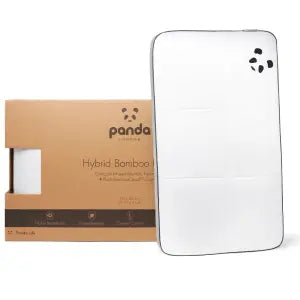 Hybrid Bamboo Pillow
Hybrid Bamboo Pillow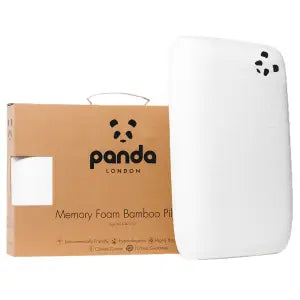 Memory Foam Bamboo Pillow
Memory Foam Bamboo Pillow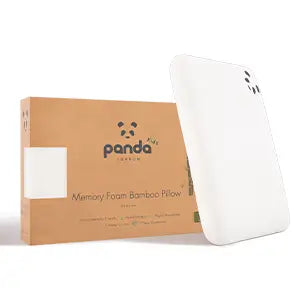 Kids Memory Foam Bamboo Pillow
Kids Memory Foam Bamboo Pillow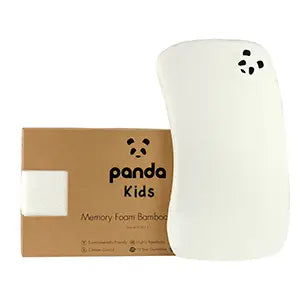 Baby Memory Foam Bamboo Pillow
Baby Memory Foam Bamboo Pillow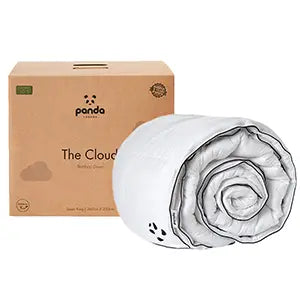 Panda Cloud Duvet
Panda Cloud Duvet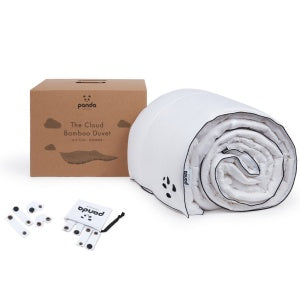 Bamboo Summer Duvet
Bamboo Summer Duvet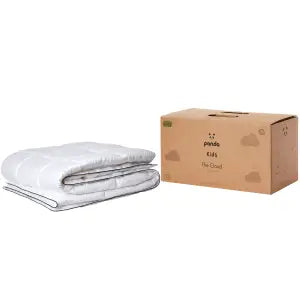 Kids Cloud Duvet
Kids Cloud Duvet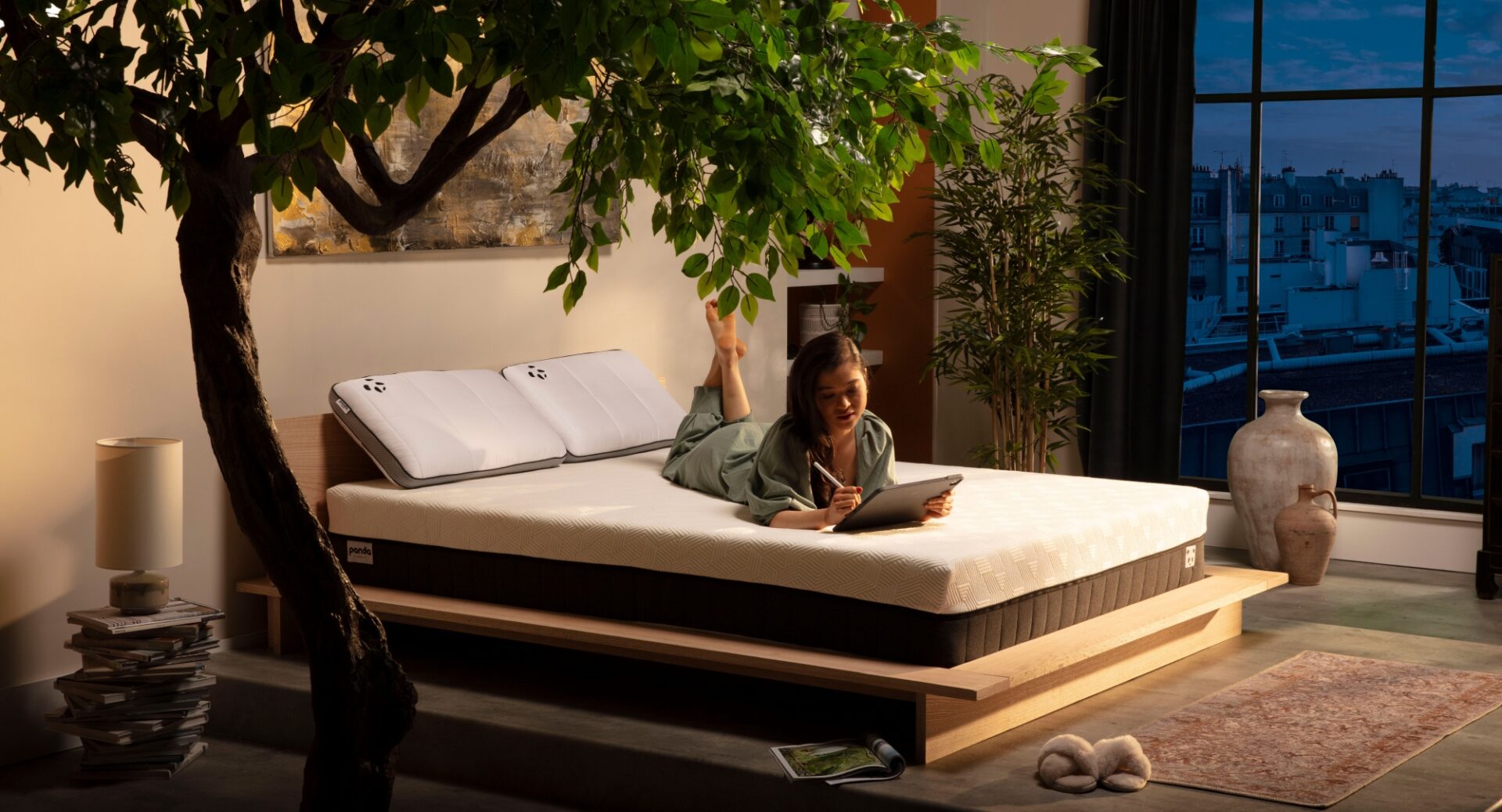
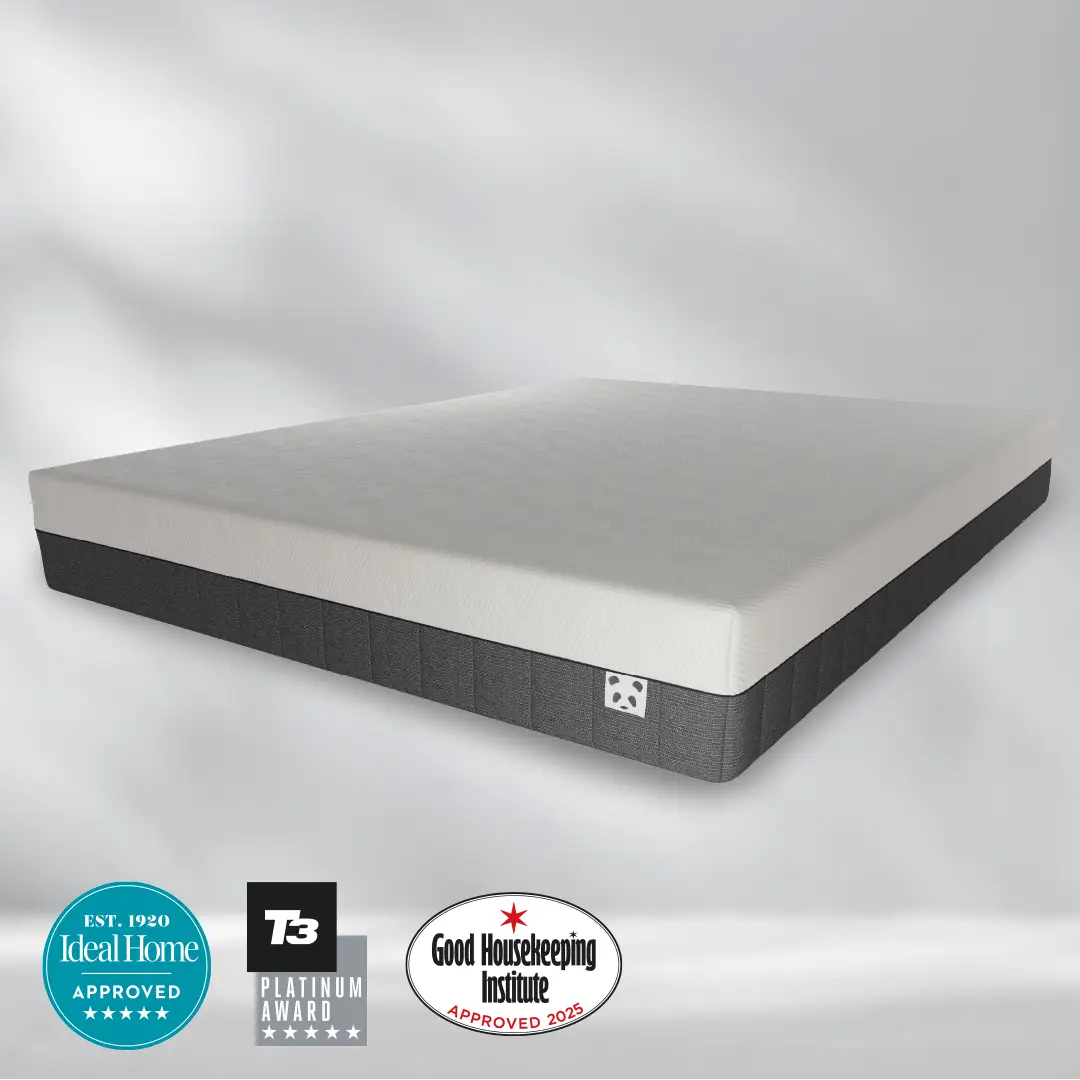
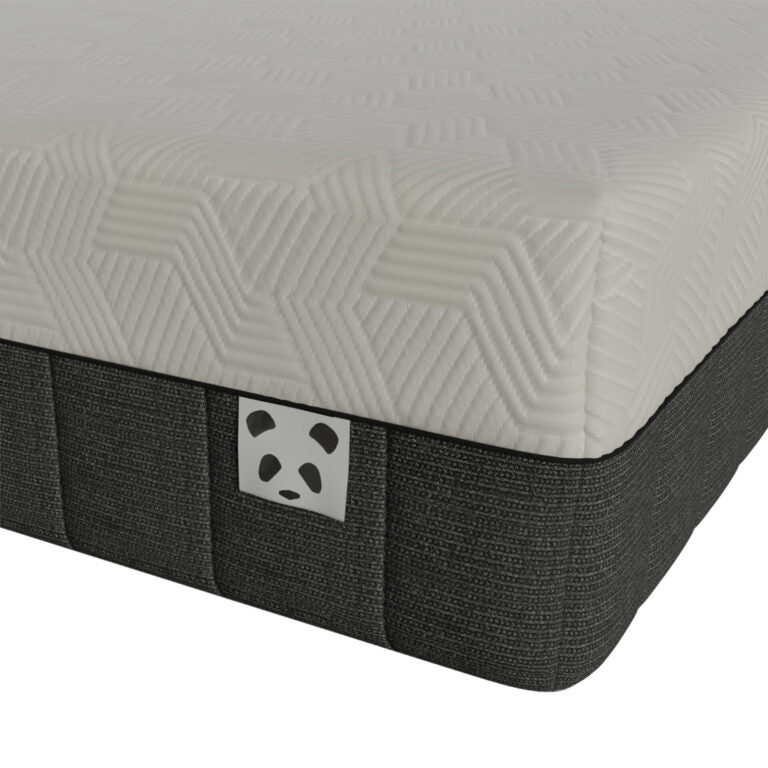
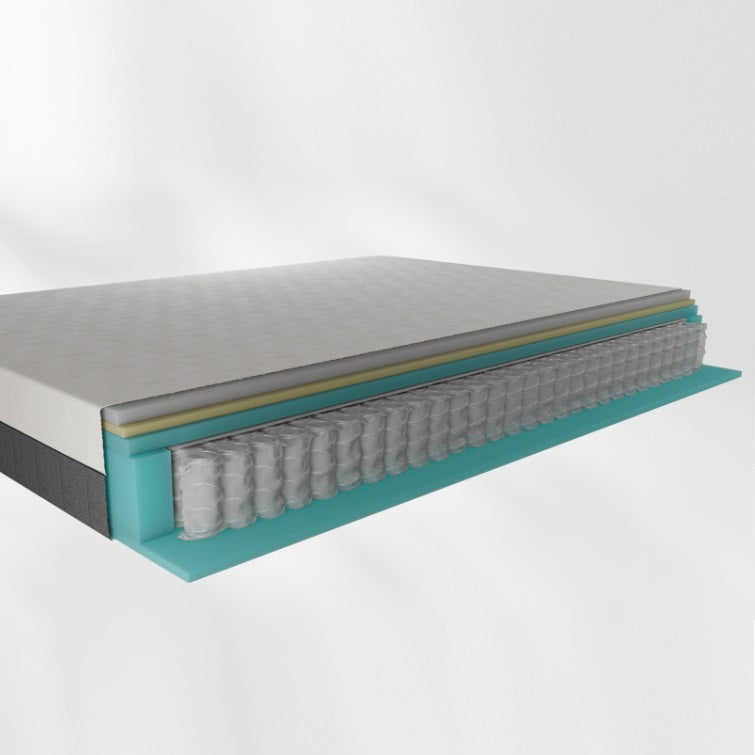
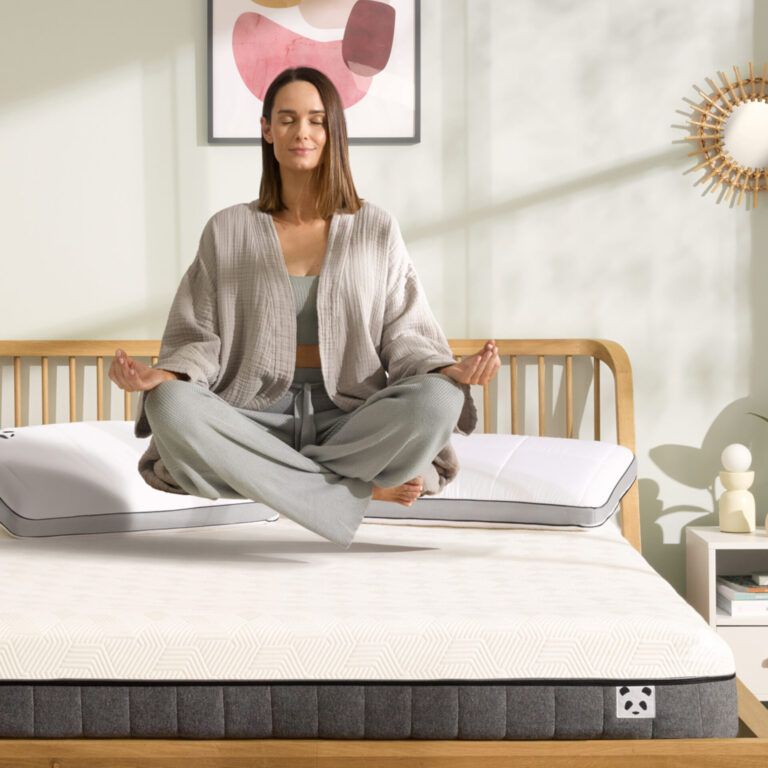
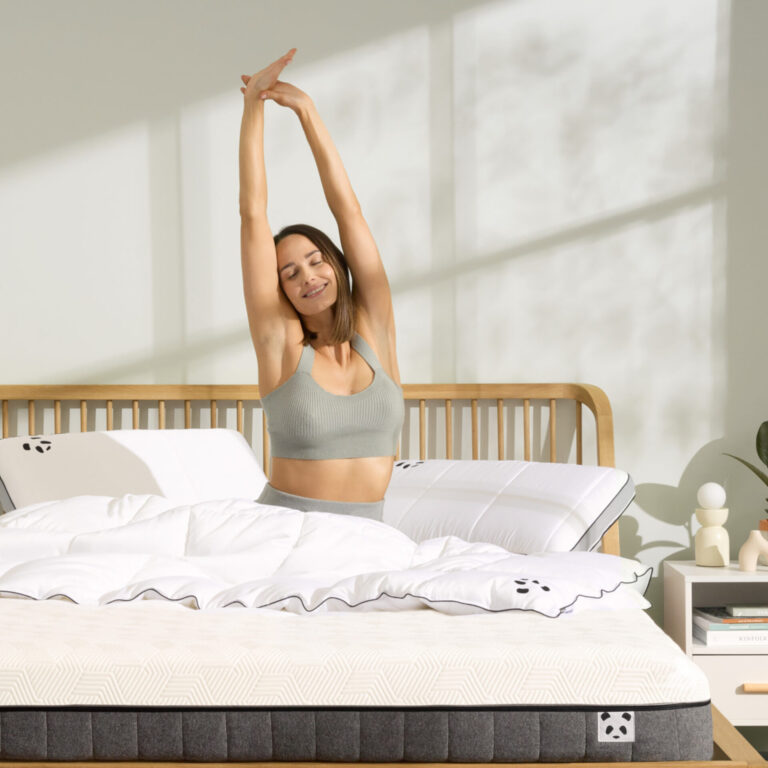
![[all] Bamboo Mattress Protector Package - PandaLondon](http://pandalondon.com/cdn/shop/files/Bamboo_Mattress_Protector_-_Packaging_Image_-_White_Background.webp?v=1721139172&width=1900)
![[all] Bamboo Mattress Protector for Hybrid Bamboo Mattress](http://pandalondon.com/cdn/shop/files/Bamboo_Mattress_Protector_New.webp?v=1721138562&width=1000)
![[all] Book on a Bamboo Mattress Protector](http://pandalondon.com/cdn/shop/products/Mattress-Protector-Listing-Images02.jpg?v=1721139189&width=1500)
![[all] Bamboo Mattress Protector Corner](http://pandalondon.com/cdn/shop/products/Mattress-Protector-Listing-Images03-e1623787734812.jpg?v=1721139189&width=1300)
![[all] Bamboo Mattress Protector Corner in line Panda London](http://pandalondon.com/cdn/shop/products/Mattress-Protector-Listing-Images04.jpg?v=1721139183&width=1500)
![[all] Panda Bamboo Mattress Protector Panda London](http://pandalondon.com/cdn/shop/files/Panda-Bamboo-Mattress-Protector-Guarantee-768x768_jpg_450393f5-91a9-499f-b15a-12d636a9a8b7.webp?v=1721139183&width=768)